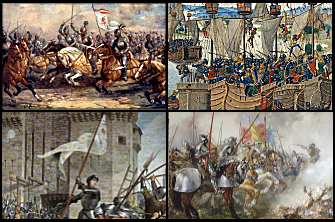The Hundred Years War
The Hundreds Years War is a period of history that saw frequent battles between the English and French between 1337 and 1453.
The origin of the war can be traced back to the reign of William the Conqueror. After becoming King of England in 1066 following the Battle of Hastings, William combined England with Normandy (France) and ruled them both himself.
The lands in France owned by the English fluctuated, but under Henry II they grew even larger and became difficult to control for subsequent kings. Significant losses across the country meant that, by the reign of Edward III in 1327, England only had control of Gascony in southern France and Ponthieu in the north.
In 1328, Charles IV of France passed away leaving no sons or brothers. However, his sister Isabella was Edward III’s mother, prompting the king to stake a claim to the French throne. However, the French felt otherwise, suggesting that Charles’ cousin Philip should be made king.

It was nine years later, in 1337, when Edward decided to fight for what he believed was rightfully his, and he declared war on the French king.
Finding an army during the autumn was difficult. Although the promises of French treasure and loot was usually enough to encourage men to join the army, many were focused on their harvest at this point in the year. However, Feudalism was still in place across England during this time, meaning that knights were legally obliged to provide soldiers upon the king’s order.
War had progressed since the Battle of Hastings and it was now the longbow that dictated the results of battles. As a result, the king’s officials were tasked with travelling around England in search of talented archers, which were seemingly readily available.
In preparation for the war, Edward called discontented acquaintanced in France into alliance, providing substantial regions of France that could be used as a base for his soldiers.
Over the following years, Edward III ordered systematic raids of key villages to damage the French economy, while simultaneously winning on the battlefield. Perhaps two of his most notable victories were his success at Crécy and his siege of Calais, which secured a key port on the channel coast.
Edward III’s heir Edward the ‘Black Prince’ also lead successful sieges across France in 1355 and 1356, resulting in victory in Poitiers and the capture of Philip’s successor John of France. However, Edward III saw failure in 1359 when he attempted to take Rheims, leading to the signing of a treaty that demanded he renounce his claim on the throne in exchange for sovereignty over some French land.
The peace did not last long. Upon the death of John of France his son Charles V was crowned king, and immediately refused to respect the treaties. This reopened the conflict, but internal issues within each country meant the war was drawn out even longer.
In England, Edward III’s grandson Richard II was replaced by another grandson, Henry IV. Meanwhile, France had many battles of its own that resulted in civil war breaking out in the early 15th Century.
Henry V, who took over the English throne in 1413 following the death of his father, saw this civil war as the opportunity to renew English claims on the French throne. His campaign started well, resulting in an alliance with groups in France. However, his death in 1422 left only an infant son in his place, while Charles’ son Charles VII was old enough to take the crown.
A turning point in the war came when Joan of Arc challenged the English army in Orléans, prompting England’s allies to question their strength.
In 1435, many of these allies changed sides, leading to Charles VII successfully conquering Normandy and Aquitaine by 1453.
See also:
MLA Citation/Reference
"The Hundred Years War". HistoryLearning.com. 2025. Web.
